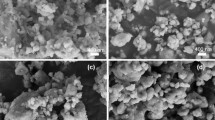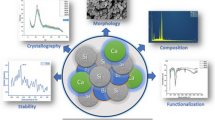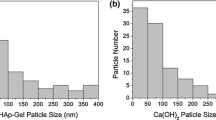Abstract
Mixed silica–calcite matrices were prepared by developing a “low” temperature (sol–gel) method in presence of several biocompatible polymers, thus providing samples with adequate porosity for the flow of biological fluids and also mechanically robust. In order to analyse and characterise the sample’s microenvironments, the highly solvatochromic probe Nile red was used, which enabled the role of polymer addition upon local environmental effects in the host media to be elucidated. The polymers used were polyethylene glycol, polymethylmethacrylate and polyethylene. Each matrix was also characterized with respect to microstructure, morphology and pore size via the use of X-ray diffractometry and scanning electron microscopy.
The results show that is was possible to obtain, in a controlled way, mixed silica–calcite matrices with a wide range of porosities (important if the material is to be used for scaffold or drug release applications, for example). The spectroscopic behaviour of Nile red when incorporated has confirmed the existence of distinct and specific local polarities within each type of matrix that may determine to a large extent the mechanism of interaction between these matrices and biological molecules.





Similar content being viewed by others
References
Rolinski OJ, Birch DJS (2002) Structural sensing using fluorescence nanotomography. J Chem Phys 116:10411–10418
Miller JN (2005) Fluorescence energy transfer methods in bioanalysis. Analyst 130:265–270
Suhling K, Siegel J, Lanigan PMP, Lévêque-Fort S, Webb SED, Phillips D, Davis DM, French PMW (2004) Time-resolved fluorescence anisotropy imaging (TR-FAIM) applied to live cells. Optics Lett 29:584–586
Antia M, Islas LD, Boness DA, Baneyx G, Vogel V (2006) Single molecule fluorescence studies of surface-adsorbed fibronectin. Biomaterials 27:679–690
Podbielska H, Ulatowska-Jarza A (2005) Sol–gel technology for biomedical engineering. Bull Pol Acad Sci Tech Sci 53:261–271
Vallet-Regi M (2001) Ceramics for medical applications. J Chem Soc Dalton Trans 2:97–108
Hall SR, Walsh D, Green D, Oreffo R, Mann S (2003) A novel route to highly porous bioactive silica gels. J Mater Chem 13:186–190
Hungerford G, Rei A, Ferreira MIC (2005) Studies on the interaction of Nile red with horseradish peroxidase in solution. FEBS J 272:6161–6169
Kubelka P (1948) New Contributions to the Optics of Intensely Light-Scattering Materials. Part I. JOSA 38:448–451
Kubelka P (1954) New Contributions to the Optics of Intensely Light-Scattering Materials Part II: Nonhomogeneous Layers. J Opt Soc Am 44:330–335
Holmes-Smith AS, Hungerford G, Uttamlal M, Amaro M, Martins P, Love G, McBrearty L, Ferreira MIC (2007) Scanning Electron Microscopy analysis of sol-gel derived biocompatible glass. Inst Phys Conf Ser (in press)
Viseu TMR, Hungerford G, Coelho AF, Ferreira MIC (2003) Dye–host interactions for local effects recognition in homogeneous and nanostructured media. J Phys Chem B 107:13300–13312
Rubio S, Gomezhens A, Valcarcel M (1986) Analytical applications of synchronous fluorescence spectroscopy. Talanta 33:633–640
Vo-Dinh T (1978) Multicomponent analysis by synchronous luminescence spectrometry. Anal Chem 50:396–401
Renge I (2000) Mechanisms of solvent shifts, pressure shifts, and inhomogeneous broadening of the optical spectra of dyes in liquids and low-temperature glasses. J Phys Chem A 104:7452–7463
Mataga N, Kubota T (1970) Molecular interactions and molecular spectra,. Marcel Dekker, New York
Lide DR (2002–2003) Handbook of chemistry and physics 83th edition,. CRC, Boca Raton
Badjić JD, Kostic NM (2000) Unexpected interactions between sol–gel silica glass and guest molecules. Extraction of aromatic hydrocarbons into polar silica from hydrophobic solvents. J Phys Chem B 104:11081–11087
Hench LL, West JK (1990) The sol–gel process. Chem Rev 90:33–72
Krishna MMG (1999) Excited-state kinetics of the hydrophobic probe Nile red in membranes and micelles. J Phys Chem A 103:3589–3595
Hungerford G, Suhling K, Ferreira JA (1999) Comparison of the fluorescence behaviour of rhodamine 6G in bulk and thin film tetraethylorthosilicate derived sol–gel matrices. J Photochem Photobiol A 129:71–80
Squires TM, Quake SR (2005) Microfluidics: Fluid physics at the nanoliter scale. Rev Modern Physics 77:977–1026
Herrmann A, Pratsch L, Arnold K, Lassmann G (1983) Effect of poly (ethylene glycol) on the polarity of aqueous-solutions and on the structure of vesicle membranes. Biochim Biophys Acta 733:87–94
Maltesh C, Somasundaran P (1992) Effect of binding of cations to polyethene-glycol on its interactions with sodium dodecyl-sulfate. Langmuir 8:1926–1930
Greenspan P, Fowler SD (1985) Spectroscopic studies of the lipid probe, Nile red. J Lipid Res 26:781–789
Sackett DL, Wolf J (1987) Nile red as a polarity-sensitive fluorescence probe of hydrophobic protein surfaces. Anal Biochem 167:228–234
Acknowledgement
The authors gratefully acknowledge the contribution of Mr. Azevedo of the Earth Sciences Department, Universidade do Minho, in the measurement of the X-ray diffractograms.
Author information
Authors and Affiliations
Corresponding author
Electronic supplementary material
Below is the link to the electronic supplementary material.
Table 1
Table detailing the spectral decomposition (in the sum of four Gaussian components) of the different Nile red containing samples, obtained with excitation at 490 nm. (PDF 318 kb)
Rights and permissions
About this article
Cite this article
Hungerford, G., Amaro, M., Martins, P. et al. Effect of Polymer Strengtheners on the Local Environment of Biocompatible Glass as Probed by Fluorescence. J Fluoresc 18, 297–303 (2008). https://doi.org/10.1007/s10895-007-0269-y
Received:
Accepted:
Published:
Issue Date:
DOI: https://doi.org/10.1007/s10895-007-0269-y




